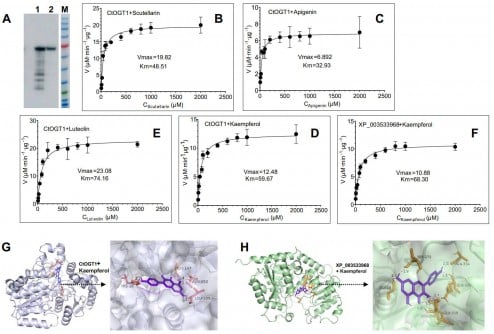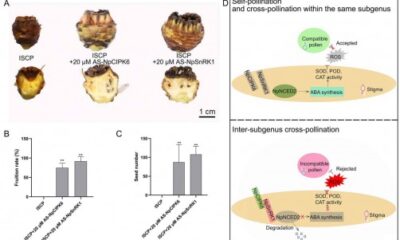Science
Scientists Discover Key Gene in Safflower’s Medicinal Properties

Research conducted by a team at Chengdu University of Traditional Chinese Medicine has identified a vital gene responsible for the biosynthesis of flavonoid glycosides in safflower (Carthamus tinctorius L.). This discovery, published on September 16, 2024, in the journal Horticulture Research, advances our understanding of safflower’s medicinal properties, especially its potential in treating cardiovascular diseases.
Safflower has been cultivated for over 4,500 years and is widely recognized for its roles in traditional medicine and natural dye production. The plant’s health benefits largely stem from compounds like hydroxysafflor yellow A (HSYA), which have been linked to therapeutic effects against conditions such as stroke and heart disease. Despite the existing knowledge of flavonoid biosynthesis pathways in model plants, safflower’s unique glycosides have remained poorly characterized.
Traditional methods for identifying genes often rely on similarities to known sequences, which can obscure species-specific details. The research team took a more innovative approach by implementing a genome-wide and multi-omics framework to directly discover functional genes within safflower. This necessitated a systematic study to uncover the genetic mechanisms behind flavonoid glycoside synthesis.
The researchers cataloged 264 cytochrome P450 (CYP) and 140 UDP-glycosyltransferase (UGT) genes from the safflower genome. By examining their evolutionary relationships, gene structures, and chromosomal locations, they narrowed down candidates likely involved in flavonoid glycoside production. Through comprehensive analyses, including transcriptome data from various tissues and developmental stages, they correlated gene expression with the accumulation of metabolites.
Notably, HSYA was found to be synthesized exclusively in safflower flowers. Among the shortlisted candidates, the gene CtOGT1 stood out as a critical enzyme. Its expression profile and phylogenetic relationship to known 7-O-glycosyltransferases provided compelling evidence of its role in biosynthesis.
To confirm these findings, the team conducted functional validation through infiltration studies in Nicotiana benthamiana and prokaryotic expression systems. These experiments validated the activity of CtOGT1, demonstrating its capability to convert flavonoids such as apigenin and scutellarein into their 7-O-glycosylated forms. Kinetic analyses revealed that CtOGT1 has a strong substrate affinity, with Km values ranging from 32.93 to 74.16 μM, depending on the flavonoid.
“This discovery marks a significant step forward in our understanding of how safflower produces its most potent bioactive compounds,” stated Dr. Jin Pei, the corresponding author of the study. He emphasized that the identification of CtOGT1 not only serves as a critical genetic tool for improving safflower quality through breeding and biotechnology but also establishes a model for studying glycosylation mechanisms in other medicinal plants.
The implications of this research extend beyond safflower itself. The gene CtOGT1 could be targeted for precision breeding strategies aimed at enhancing the production of medicinal flavonoid glycosides, which are crucial for developing cardiovascular therapies rooted in traditional Chinese medicine.
Moreover, the methodology employed in this study, combining genome-wide screening with multi-omics integration, holds promise for uncovering key metabolic genes in other economically significant plants. Future investigations may delve into the regulatory networks involving CtOGT1 and explore synthetic biology applications for producing flavonoid glycosides in microbial or heterologous systems, facilitating scalable pharmaceutical production.
This comprehensive research underscores the potential of safflower as a source of valuable medicinal compounds and highlights the importance of modern genomic techniques in botanical studies. The findings not only contribute to the field of pharmacognosy but also pave the way for innovative approaches to enhance the therapeutic potential of traditional herbal medicines.
-

 Technology5 months ago
Technology5 months agoDiscover the Top 10 Calorie Counting Apps of 2025
-

 Technology3 weeks ago
Technology3 weeks agoOpenAI to Implement Age Verification for ChatGPT by December 2025
-

 Health3 months ago
Health3 months agoBella Hadid Shares Health Update After Treatment for Lyme Disease
-

 Health3 months ago
Health3 months agoAnalysts Project Stronger Growth for Apple’s iPhone 17 Lineup
-

 Health4 months ago
Health4 months agoErin Bates Shares Recovery Update Following Sepsis Complications
-

 Technology5 months ago
Technology5 months agoDiscover How to Reverse Image Search Using ChatGPT Effortlessly
-

 Technology3 months ago
Technology3 months agoElectric Moto Influencer Surronster Arrested in Tijuana
-

 Technology5 months ago
Technology5 months agoMeta Initiates $60B AI Data Center Expansion, Starting in Ohio
-

 Technology2 months ago
Technology2 months agoDiscover 2025’s Top GPUs for Exceptional 4K Gaming Performance
-

 Technology5 months ago
Technology5 months agoRecovering a Suspended TikTok Account: A Step-by-Step Guide
-

 Health5 months ago
Health5 months agoTested: Rab Firewall Mountain Jacket Survives Harsh Conditions
-

 Lifestyle5 months ago
Lifestyle5 months agoBelton Family Reunites After Daughter Survives Hill Country Floods















